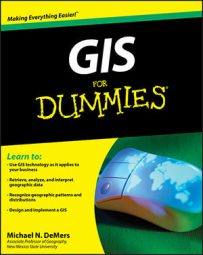Your GIS (geographic information system) is very handy and a great navigation tool, but what you see on the GIS screen isn't necessarily what the actual terrain looks like. As you use your GIS, remember the following facts:
| Map Characteristic | What It Means |
|---|---|
| Maps are models — not miniatures | Maps generalize geographic features by using symbols so that all features will fit the specified output size. |
| Map scale has a huge impact on GIS analysis | Small-scale maps cover large areas with little detail, and large-scale maps cover small areas with lots of detail. |
| Maps are a flat model of a spherical earth | Maps use projections to compensate for the flat versus spherical issue, and each projection has its own type and amount of distortion. |
| Maps have a reference grid, or coordinate system | The reference grid helps you navigate the map and links the spherical earth to the map projection. |
| Maps have a reference starting point, or datum. | Datums are based on a model of the Earth called a reference ellipsoid and enable all the various projections in a GIS work together to give an accurate picture of the Earth. |

